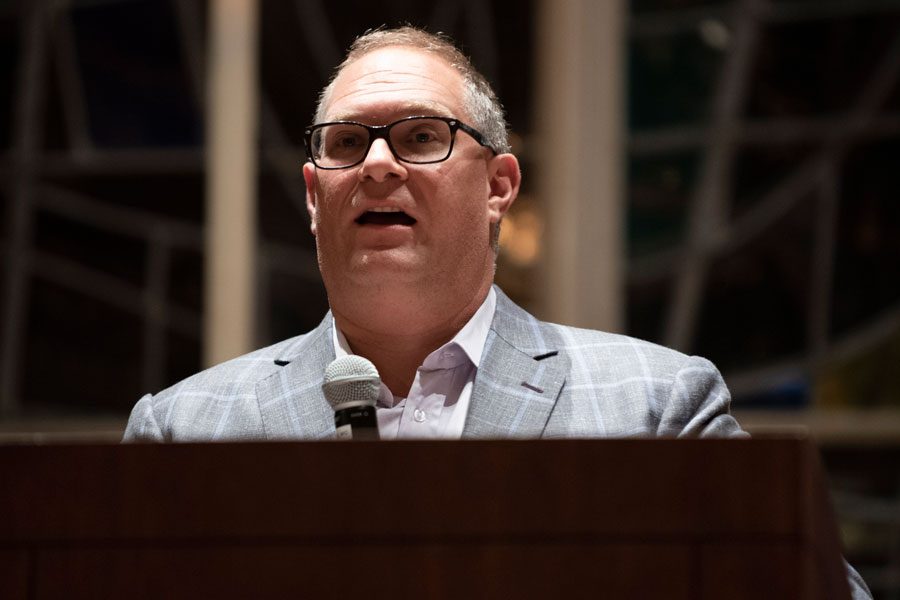SESP pilot program to give work-study students stipend during practicum
Colin Boyle/Daily Senior Staffer
SESP Dean David Figlio. The School of Education and Social Policy is piloting the Undergraduate Practicum and Student Teaching Support Fund program to provide a stipend for students who are part of a federal work study program during their SESP practicum.
November 8, 2019
In response to student recommendations, the School of Education and Social Policy is piloting the Undergraduate Practicum and Student Teaching Support Fund program to provide a stipend for students who are part of a federal work study program during their SESP practicum.
The SESP practicum is an off-campus, quarter-long internship mandatory for all SESP students. As their final project in a SESP class taught by SESP Dean David Figlio, a group of students created a policy recommendation to make the practicum more financially accessible for work-study students. The school adopted the policy this quarter after students presented the recommendation to Figlio and other University administrators last spring.
The pilot program will provide a $1,100 stipend to students on the work-study program — under the $1,200 that the students proposed in the project — and will run for three years. The project identified parts of the practicum that disadvantaged low-income students. In their presentation, they said “students were essentially paying NU to have an internship.”
Many students were not paid while completing their practicums because they often work for nonprofit organizations. SESP does not guarantee that students will be compensated for their practicums. However, students still have to cover expenses such as meals and transportation, and because practicum counts as four units of credit toward their majors, they have to pay tuition.
A SESP survey found that 45 percent of students didn’t have time to work another job on campus during practicum, and of students who kept their jobs, 73 percent were forced to work reduced hours. To maintain their income, some students worked over 50 hours a week at multiple jobs, while others resorted to cutting down on daily living costs.
“Most of the strain was from not being able to work (for pay) during my Practicum,” a student said in the comments section of the survey. “I budget(ed) my money for the quarter, without my work pay I had to reduce my food budget and personal toiletries budget in order to make ends meet. I ate a lot of tuna and oranges to afford the budget restriction for that quarter.”
SESP junior Mary Tucker, one of the students who worked on the policy, said she wanted to address the issue after she realized students were paying a full quarter of tuition to take part in unpaid internships.
“You are literally paying an entire quarter’s worth of tuition,” Tucker said. “That sounds a little bizarre and was kind of weird to come to terms with, and I think that’s really what made me interested in doing this project.”
For Larissa Edwards, a SESP junior and one of the students who worked on the project, this issue was especially relevant. Edwards, a first-generation and low-income student, chose to do her practicum last summer because she was able to apply to the Summer Internship Grant Program and receive financial aid.
The students also compared SESP’s practicum to the Journalism Residency program in the Medill School of Journalism, Media, Integrated Marketing Communications which is also mandatory for undergraduate journalism majors. However, journalism students are either paid during their residencies or are given a $1,250 grant.
“I know sometimes it’s difficult because I went to a nonprofit this summer,” Edwards said. “And they usually don’t have the resources to pay. But I would love something that’s similar to the JR.”
Because the program is limited to work study students, other students with financial constraints were excluded from getting a stipend. Edwards is an international student and does not qualify for federal work-study.
Students who receive financial aid could use a quarter of their aid toward the practicum. However, the University still limited students to 12 quarters of financial aid, so students who completed their practicums over the summer need to graduate early or lose their aid, Edwards said.
The University changed the policy to four years of financial aid last spring, accommodating extra quarters over the summer, but some students still have to graduate early. Elijah Beal, SESP senior and a low-income student, had to use his financial aid when he did his practicum in the summer and now must graduate early.
“There’s still barriers to have assistance,” Beal said. “(This program) is not the end-all-be-all solution to everything. But I think it’s a good step forward.”
Email: [email protected]
Twitter: @neyachalam


